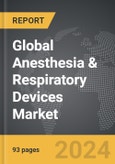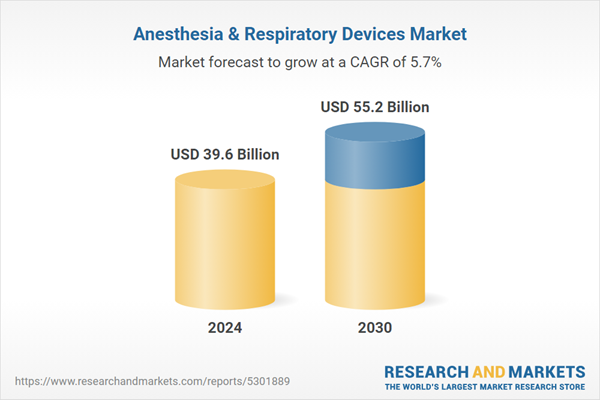The global market for Anesthesia & Respiratory Devices was valued at US$39.6 Billion in 2024 and is projected to reach US$55.2 Billion by 2030, growing at a CAGR of 5.7% from 2024 to 2030. This comprehensive report provides an in-depth analysis of market trends, drivers, and forecasts, helping you make informed business decisions. The report includes the most recent global tariff developments and how they impact the Anesthesia & Respiratory Devices market.
Segments: Product (Respiratory Devices, Anesthesia Devices).
Geographic Regions/Countries: World; United States; Canada; Japan; China; Europe (France; Germany; Italy; United Kingdom; Spain; Russia; and Rest of Europe); Asia-Pacific (Australia; India; South Korea; and Rest of Asia-Pacific); Latin America (Argentina; Brazil; Mexico; and Rest of Latin America); Middle East (Iran; Israel; Saudi Arabia; United Arab Emirates; and Rest of Middle East); and Africa.
The analysts continuously track trade developments worldwide, drawing insights from leading global economists and over 200 industry and policy institutions, including think tanks, trade organizations, and national economic advisory bodies. This intelligence is integrated into forecasting models to provide timely, data-driven analysis of emerging risks and opportunities.
Global Anesthesia & Respiratory Devices Market - Key Trends and Drivers Summarized
What Are Anesthesia & Respiratory Devices, And Why Are They So Essential?
Anesthesia and respiratory devices play a pivotal role in modern healthcare by ensuring patient safety during surgery, medical procedures, and in the management of chronic respiratory conditions. Anesthesia devices are designed to deliver a controlled amount of anesthetic gases to patients, allowing them to undergo surgeries and other invasive procedures without pain or awareness. These systems consist of complex components, including ventilators, monitors, vaporizers, and breathing circuits, all working together to administer precise doses of anesthesia while maintaining respiratory function. On the other hand, respiratory devices cover a wide range of equipment used to support or enhance breathing, particularly for patients suffering from respiratory conditions such as chronic obstructive pulmonary disease (COPD), asthma, or sleep apnea. These devices include ventilators, oxygen concentrators, inhalers, and nebulizers, all of which are vital in both acute and chronic care settings. As medical science continues to advance, these devices have become increasingly sophisticated, offering more precise control and monitoring capabilities that improve patient outcomes and reduce the risks associated with anesthesia and respiratory compromise.How Do Anesthesia & Respiratory Devices Benefit Various Healthcare Applications?
Anesthesia and respiratory devices are indispensable across numerous healthcare settings, from operating rooms and intensive care units to outpatient clinics and even home care environments. In surgical settings, anesthesia devices allow for the precise administration of anesthetics, maintaining the patient’s unconsciousness and controlling their vital functions such as breathing and circulation. These devices are especially important in complex and prolonged surgeries where the patient’s body needs to be closely monitored to ensure stability throughout the procedure. Respiratory devices, meanwhile, are crucial for patients with breathing difficulties. Ventilators, for instance, are used to support patients who cannot breathe adequately on their own, whether due to an acute condition like pneumonia or as part of long-term treatment for chronic diseases such as COPD. Home-based respiratory devices, such as continuous positive airway pressure (CPAP) machines for sleep apnea, allow patients to manage their conditions outside of a hospital, improving quality of life and reducing the need for hospitalization. The use of portable oxygen concentrators has similarly revolutionized care for patients with chronic respiratory diseases, offering greater mobility and independence. As the global population ages and the prevalence of respiratory illnesses rises, the demand for these devices in various healthcare settings continues to expand, making them a cornerstone of patient care.What Types of Anesthesia & Respiratory Devices Are Available, And How Do They Differ?
The variety of anesthesia and respiratory devices reflects the diverse needs they address in clinical and home care environments. Anesthesia devices encompass several key components, including anesthesia machines, ventilators, and monitoring systems. Modern anesthesia machines are highly advanced, integrating ventilators that automatically adjust to the patient’s breathing needs, while also incorporating monitoring equipment to track vital signs and ensure safe anesthesia delivery. These machines can deliver both inhalational anesthetics and intravenous drugs, with precise control over dosage and timing. Respiratory devices are similarly diverse, ranging from life-saving ventilators, which are critical in both intensive care units and during surgeries, to portable oxygen concentrators used by patients with chronic lung diseases. Inhalers and nebulizers are also commonly used to deliver medication directly into the lungs for conditions like asthma and COPD. CPAP machines, which help patients with sleep apnea by providing continuous airflow to keep airways open during sleep, are a vital part of home-based respiratory care. The differences in these devices largely reflect their intended uses - some are designed for long-term management of chronic conditions, while others are critical for acute care in hospital settings. In all cases, these devices are increasingly incorporating digital technology, allowing for more accurate dosing, real-time monitoring, and data-driven care decisions.What’s Driving the Growth in the Anesthesia & Respiratory Devices Market?
The growth in the anesthesia and respiratory devices market is driven by several factors, including the increasing prevalence of respiratory diseases, the rising number of surgeries worldwide, and technological advancements that are making these devices more effective and accessible. One of the primary drivers is the global rise in chronic respiratory conditions such as asthma, COPD, and sleep apnea, which is closely tied to factors like aging populations, urban pollution, and lifestyle changes. As the number of people affected by these conditions increases, so does the demand for respiratory support devices, especially those designed for long-term use in home care settings. Additionally, the ongoing COVID-19 pandemic has highlighted the critical role of ventilators and other respiratory devices in managing severe respiratory infections, further boosting the market’s expansion. Another significant factor is the growing number of surgeries, driven by advances in medical science, which has increased the need for reliable anesthesia devices that ensure patient safety during complex procedures. Furthermore, the trend toward minimally invasive surgeries, which require precise anesthesia control, has contributed to the market’s growth. Technological advancements, such as the integration of digital monitoring, automation, and AI in both anesthesia and respiratory devices, are improving the accuracy of treatments, reducing the risk of complications, and enabling remote monitoring - making these devices more attractive to healthcare providers and patients alike. Lastly, there is a growing demand for portable and user-friendly devices that allow patients to manage chronic conditions at home, reducing hospital readmissions and healthcare costs, while improving patient autonomy and quality of life. This convergence of medical needs, technological innovation, and healthcare trends is fueling significant growth in the anesthesia and respiratory devices market.Report Scope
The report analyzes the Anesthesia & Respiratory Devices market, presented in terms of units. The analysis covers the key segments and geographic regions outlined below.Segments: Product (Respiratory Devices, Anesthesia Devices).
Geographic Regions/Countries: World; United States; Canada; Japan; China; Europe (France; Germany; Italy; United Kingdom; Spain; Russia; and Rest of Europe); Asia-Pacific (Australia; India; South Korea; and Rest of Asia-Pacific); Latin America (Argentina; Brazil; Mexico; and Rest of Latin America); Middle East (Iran; Israel; Saudi Arabia; United Arab Emirates; and Rest of Middle East); and Africa.
Key Insights:
- Market Growth: Understand the significant growth trajectory of the Respiratory Devices segment, which is expected to reach US$36.2 Billion by 2030 with a CAGR of a 6.1%. The Anesthesia Devices segment is also set to grow at 5.0% CAGR over the analysis period.
- Regional Analysis: Gain insights into the U.S. market, valued at $10.2 Billion in 2024, and China, forecasted to grow at an impressive 9.5% CAGR to reach $13.6 Billion by 2030. Discover growth trends in other key regions, including Japan, Canada, Germany, and the Asia-Pacific.
Why You Should Buy This Report:
- Detailed Market Analysis: Access a thorough analysis of the Global Anesthesia & Respiratory Devices Market, covering all major geographic regions and market segments.
- Competitive Insights: Get an overview of the competitive landscape, including the market presence of major players across different geographies.
- Future Trends and Drivers: Understand the key trends and drivers shaping the future of the Global Anesthesia & Respiratory Devices Market.
- Actionable Insights: Benefit from actionable insights that can help you identify new revenue opportunities and make strategic business decisions.
Key Questions Answered:
- How is the Global Anesthesia & Respiratory Devices Market expected to evolve by 2030?
- What are the main drivers and restraints affecting the market?
- Which market segments will grow the most over the forecast period?
- How will market shares for different regions and segments change by 2030?
- Who are the leading players in the market, and what are their prospects?
Report Features:
- Comprehensive Market Data: Independent analysis of annual sales and market forecasts in US$ Million from 2024 to 2030.
- In-Depth Regional Analysis: Detailed insights into key markets, including the U.S., China, Japan, Canada, Europe, Asia-Pacific, Latin America, Middle East, and Africa.
- Company Profiles: Coverage of players such as B. Braun Melsungen AG, Charts Industries, Drägerwerk AG & Co. KGaA, Fisher & Paykel Healthcare Limited, GE Healthcare and more.
- Complimentary Updates: Receive free report updates for one year to keep you informed of the latest market developments.
Some of the 42 companies featured in this Anesthesia & Respiratory Devices market report include:
- B. Braun Melsungen AG
- Charts Industries
- Drägerwerk AG & Co. KGaA
- Fisher & Paykel Healthcare Limited
- GE Healthcare
- Getinge AB
- Masimo Corporation
- Medtronic Plc
- Philips Healthcare
- ResMed
Tariff Impact Analysis: Key Insights for 2025
Global tariff negotiations across 180+ countries are reshaping supply chains, costs, and competitiveness. This report reflects the latest developments as of April 2025 and incorporates forward-looking insights into the market outlook.The analysts continuously track trade developments worldwide, drawing insights from leading global economists and over 200 industry and policy institutions, including think tanks, trade organizations, and national economic advisory bodies. This intelligence is integrated into forecasting models to provide timely, data-driven analysis of emerging risks and opportunities.
What’s Included in This Edition:
- Tariff-adjusted market forecasts by region and segment
- Analysis of cost and supply chain implications by sourcing and trade exposure
- Strategic insights into geographic shifts
Buyers receive a free July 2025 update with:
- Finalized tariff impacts and new trade agreement effects
- Updated projections reflecting global sourcing and cost shifts
- Expanded country-specific coverage across the industry
Table of Contents
I. METHODOLOGYII. EXECUTIVE SUMMARY2. FOCUS ON SELECT PLAYERSIII. MARKET ANALYSISIV. COMPETITION
1. MARKET OVERVIEW
3. MARKET TRENDS & DRIVERS
4. GLOBAL MARKET PERSPECTIVE
UNITED STATES
CANADA
JAPAN
CHINA
EUROPE
FRANCE
GERMANY
ITALY
UNITED KINGDOM
SPAIN
RUSSIA
REST OF EUROPE
ASIA-PACIFIC
AUSTRALIA
INDIA
SOUTH KOREA
REST OF ASIA-PACIFIC
LATIN AMERICA
ARGENTINA
BRAZIL
MEXICO
REST OF LATIN AMERICA
MIDDLE EAST
IRAN
ISRAEL
SAUDI ARABIA
UNITED ARAB EMIRATES
REST OF MIDDLE EAST
AFRICA
Companies Mentioned (Partial List)
A selection of companies mentioned in this report includes, but is not limited to:
- B. Braun Melsungen AG
- Charts Industries
- Drägerwerk AG & Co. KGaA
- Fisher & Paykel Healthcare Limited
- GE Healthcare
- Getinge AB
- Masimo Corporation
- Medtronic Plc
- Philips Healthcare
- ResMed
Table Information
| Report Attribute | Details |
|---|---|
| No. of Pages | 93 |
| Published | April 2025 |
| Forecast Period | 2024 - 2030 |
| Estimated Market Value ( USD | $ 39.6 Billion |
| Forecasted Market Value ( USD | $ 55.2 Billion |
| Compound Annual Growth Rate | 5.7% |
| Regions Covered | Global |









